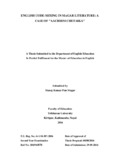Please use this identifier to cite or link to this item:
https://elibrary.tucl.edu.np/handle/123456789/1941| Title: | English Code-Mixing in Magar Literature |
| Other Titles: | A Case of "Aachhim Chetaika" |
| Authors: | Pun Magar, Manoj Kumar |
| Keywords: | Literature;Story;Study and teaching;English language |
| Issue Date: | 2016 |
| Publisher: | Faculty of Education Tribhuvan University Kirtipur, Kathmandu, Nepal |
| Abstract: | This study entitled English Code-mixing in Magar Literature: A Case of Aachhim Chetaika aimed to identify the mixed English codes and situational contexts from the collection of story in the Magar Kham literature. I collected the data from primary and secondary sources for this study. For primary source, I selected five different Magar Kham literary figures including author of the story by using purposive non-random sampling procedure. Questionnaire was used as a tool to collect the data from primary source. Likewise, I employed the observation checklist as a tool for the secondary source of data collection. After analyzing the collected data, this research concludes that the English code- mixing in the Magar kham literature is being common phenomenon. From the findings of this study, it can be concluded that the 75 mixed codes and different 20 situational contexts were found in the story. Likewise, different five literary figures responded that the main reasons for code-mixing are lack of equivalent terms in the Magar Kham language, linguistic imperialism, lack of language transfer to the younger generation and influence of western cultures. This study consists of five chapters. Chapter one deals with background of the study, objectives of the study, research questions, significance of the study, delimitations of the study and operational definition of the key terms. The second chapter consists of review of theoretical literature, review of related empirical literature, implication of the review of the study and conceptual framework. The third chapter deals with design of the study, population, sample and sampling procedures, study area/field, tools and techniques for data collection, data collection procedures and data analysis and interpretation procedures. Similarly, the fourth chapter covers analysis of data and interpretation of results and the last chapter incorporates conclusion and recommendations. The final section of the study incorporates references and appendices. |
| URI: | http://elibrary.tucl.edu.np/handle/123456789/1941 |
| Appears in Collections: | English Language Education |
Items in DSpace are protected by copyright, with all rights reserved, unless otherwise indicated.

